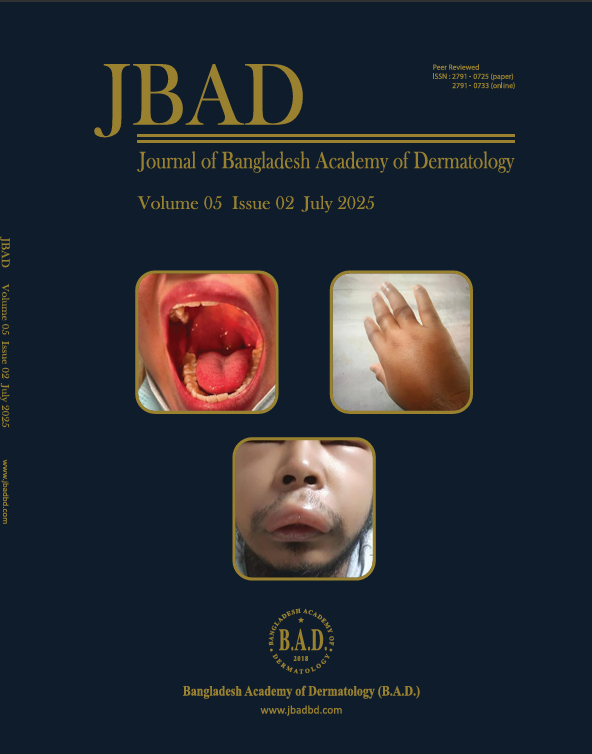Original Article
Hidradenitis Suppurativa: Current Trends of Treatment in Bangladesh
Author Details
1. Junior consultant, Department of Dermatology & Venereology, Mugda Medical College Hospital, Dhaka, Bangladesh. E-mail: dr.afrozajesmin@gmail.com
2. Professor, Department of Dermatology & Venereology, Bangabandhu Sheikh Mujib Medical University, Dhaka, Bangladesh.
3. Assistant Professor, Department of Dermatology & Venereology, Mugda Medical College Hospital, Dhaka, Bangladesh.
4. Associate Professor, Department of Dermatology & Venereology, Mugda Medical College Hospital, Dhaka, Bangladesh.
5. Consultant Dermatologist, Matador Diagnostic & Wellness Center, Dhaka, Bangladesh.
6. Consultant, Department of Dermatology &Venereology, Dhaka Medical College Hospital, Dhaka, Bangladesh.
7. Associate Professor, Department of Dermatology & Venereology, Bangabandhu Sheikh Mujib Medical University, Dhaka, Bangladesh.
8. Professor, Department of Dermatology & Venereology, Mugda Medical College Hospital, Dhaka, Bangladesh.
Abstract Background: Hidradenitis suppurativa (HS) is a chronic, recurrent, debilitating dermatosis. Management of HS remains a challenge owing to lack of a curative medical treatment, potential resistance of recommended antibiotics and higher cost of biologics. Objectives: The study aimed to assess the current trends in treatment patterns of Hidradenitis suppurativa in Bangladesh. Methods: The cross-sectional study was conducted between January 2023 and March 2023 among 76 dermatologists from all over Bangladesh. A pretested, semi-structured questionnaire containing 13 questions targeted mainly prescribing patterns based on their regular clinical practices. The data has been collected through both online and in-person interviews. Results: The study found that topical+systemic antibiotics were the most frequently used treatment modality for HS in all severity groups. Doxycycline was the most preferred systemic antibiotic, followed by Clindamycin. Most of the dermatologists (79%) did not prescribe the combination therapy of clindamycin + rifampicin as a reason for drug resistance (51.7%) and unavailability (46.6%). However,46% prioritized isotretinoin as non-antibiotic treatment and 78% have never given biologics for HS treatment. When it comes to surgical intervention, almost half (43.4%) of the dermatologists never performed any surgical procedure in clinical practices and they referred the patients to a plastic surgeon (30.2%). The study explored the challenges of HS treatment in Bangladesh, including the chronic nature of the disease (76.3%) and patients not compliant with prescribed treatment (52.6%) as challenges in treating HS treatment. Conclusion: Identifying and addressing barriers to achieving expertise in the treatment of HS can help provide access to high-quality care for patients with HS. Keyword: Hidradenitis Suppurativa, combination therapy, non-antibiotic therapy, Biologics. |
Keywords: Hidradenitis Suppurativa, Combination Therapy, Non-Antibioyic Therapy, Biologic

